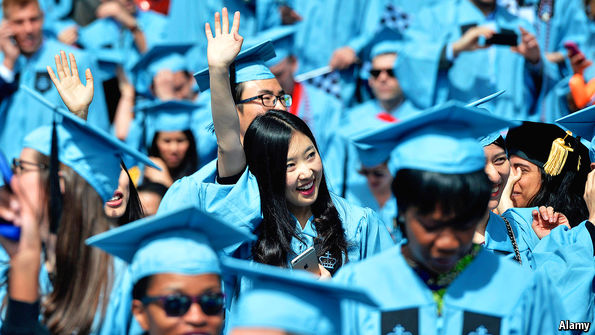
Canada and Australia seek to attract more foreign students
Foreign study took off in the 1980s, when several rich countries started to offer large numbers of scholarships as part of their aid programmes. Rising incomes in poorer countries added a financial motive. Universities in rich countries are often constrained by their governments in how many locals they can recruit and how much they can charge them. Foreigners, who can be charged more, help pad out budgets and subsidise local students. But not every country lucky enough to have lots of foreign students is doing what is needed to keep them coming.
Today Anglophone countries take the biggest share, since English is quite a useful language to acquire. France is popular with bits of its former empire and pupils from the French-language schools around the world that France’s government subsidises. Germany, which has started to offer postgraduate courses in English and has abolished all tuition fees, even for foreigners, also takes large numbers.
America leads in absolute terms, with 975,000 foreign students in 2014-15. Its best universities have long attracted the very brightest foreign minds, especially in the sciences, often luring them with generous scholarships. But for its size its performance is less impressive: just 5% of all students on its campuses are from abroad.
One reason is tighter visa rules imposed after the terrorist attacks of 2001; another is that students must seek special permission to work off-campus while studying, and it is hard to stay and work for long after graduating. Longer-term employment visas are also hard to get, so many students without deep pockets choose to go elsewhere so they can defray some of the cost. And most American institutes refuse to pay education agents—consultants who help youngsters, particularly in Asia, to choose institutions and apply to them. According to i-graduate, a consultancy, agents rank America as the most attractive destination, but are less likely to recommend American institutions, as they mostly work on commission.
Students usually choose their target country first and then decide which college to apply to. That means national advertising strategies matter, says Mark Reid of the University of Miami. But America has none, leaving individual institutions to promote themselves overseas. Mr Reid and his staff give presentations at international schools and attend trade fairs in around 65 countries each year. This has paid off: the proportion of Miami’s students who are foreign is three times the national average. Latin Americans like living in a Hispanic-majority city. Chinese students became interested in 2009, when Miami broke into the top 50 of the ranking of American universities produced by US News and World Report.
Higher learning, down under
Australia, by contrast, has long seen international students—and their fees—as a national priority. Education is the country’s second-biggest export industry, behind only mining, worth A$18 billion ($15 billion) in 2015. A quarter of all its students—and in business and management courses, close to half—are from abroad. At a couple of particularly enterprising institutions, Australian-born students are a minority.
Australia’s allure faded between 2009 and 2012, partly because of a strong currency but also because racist attacks against Indian students in Melbourne, and the collapse of some poorly run private colleges, tarnished its image overseas. A government crackdown on visa scams and low-quality courses drew attention to uneven provision and slowed visa-processing times for all students, even those applying to elite institutions. As the currency has fallen and visa rules have been relaxed again, applications have rebounded. The tale offers two morals, says David Hetherington of Per Capita, a think-tank in Sydney. First, foreign students need clear visa rules and the right to work while they study. Second, the national brand matters.
Canada, where universities until recently had few foreign students, has learned from Australia’s experience. About a decade ago its government decided that universities could bolster their finances by admitting more foreign students paying higher fees, and that after graduation those students would be a valuable source of well-qualified young workers. Immigration rules were always quite favourable, says Paul Brennan of Colleges and Institutes Canada, an industry organisation, but until recently there was no clear path from study to work and then permanent residence. Now, if new graduates can find a job they can automatically stay in Canada for up to three years, depending on the length of their courses. That work experience is then taken into account if they apply for permanent residency.
A collaboration between colleges, universities and Canada’s immigration office has brought down visa-rejection rates for Indian students, a target market. A quarter of all foreign students—and half of those from India and China—end up being granted permanent residence. Recent growth in international-student numbers has largely come in shorter college and polytechnic courses, says Mr Brennan. These are popular with Indians who already have degrees but cannot find work—and with youngsters from unemployment-plagued Italy and Spain. The number of Indian students arriving for such courses rose from 1,200 in 2008 to 14,000 last year.
Britain, too, sees policy on international students as intertwined with immigration policy, but has taken the opposite tack. Its universities have a cachet among foreigners. Overall, 14% of students on its campuses come from outside the European Union. Another 5% come from other EU countries (under EU rules they are admitted on the same basis as locals, and pay the same fees). In 2013-14 English universities took in £3.3 billion of non-EU student fees, which are not capped by the government, 13% of revenue. Half of those studying full-time for work-focused master’s degrees are from outside the EU, and research by the British Council shows that in some scientific fields, such as electronic engineering and biosciences, the share is over 80%.
But in recent years this success story has been threatened by a populist pledge made in 2010 by the Conservative Party, then in opposition, to cut net immigration to 100,000 people a year. With many immigrants entering Britain from bits of its former empire under family-reunion laws, and free movement within the EU, most immigration is outside the government’s power to stop. Non-EU students are the main exception. In power the Conservatives have sought to keep them out by tightening visa rules, raising application costs, restricting students’ right to work part-time during their courses and making it far harder to stay after graduation.
The result is visible in the figures. In 2014-15 the number of new students from outside the EU fell by 3%, even as the number of foreign students worldwide rose strongly. Britain’s three big English-speaking competitors all saw strong growth. Chinese students, who are often leaving to escape the gaokao, China’s vicious university-entrance exam, rather than because they want to earn money in a richer country or emigrate, are still coming. But applications from Indians and Pakistanis, who typically need to work while studying and for a year or two afterwards to afford the fees, have fallen by half.
Britain is dangerously exposed to a slackening of demand from China, says Will Archer of i-graduate. He also notes that education agents have become less likely to regard Britain as an attractive destination—even though more of its international students rate their education highly, and more say they are satisfied with their experience and would recommend Britain to other students, than anywhere else.
Learning’s allure
The quality of education in some countries that have long sent many students abroad is improving. Local hubs such as Singapore and Hong Kong are growing more popular: of Asians who study abroad, the proportion who do so in Asia rose from 36% in 1999 to 42% in 2007. And more students are plumping for “transnational” rather than international study, says Michael Peak of the British Council: mixing and matching local and foreign provision, for example by starting degrees at home and taking just a final year abroad.
The trend is most evident in executive education, which is less about the chance to work in a rich country and more about gaining international experience, says Andrew Crisp of CarringtonCrisp, an education-marketing firm. A growing share of MBAs and executive master’s courses are now offered by partnerships or groups of institutions, with students expected to spend time in several different locations. Online education, too, could cut demand for pricey overseas study, if not by replacing it then by allowing students to do part of a foreign institution’s courses more cheaply from home.
English-speaking countries have benefited hugely from international students. Those students have subsidised locals, kept courses in the hard sciences viable, acted as informal ambassadors on their return—and eased skills shortages when they have stayed. Some countries have seized the opportunity; others have taken it for granted. More fool them.
Please confirm If you want to unregister
You have been unregistered from gradlink







